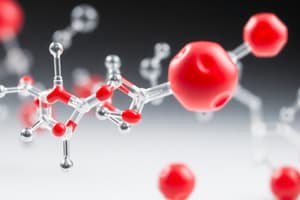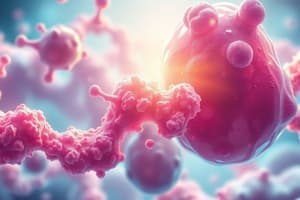Podcast
Questions and Answers
What are the two main types of enzyme inhibition?
What are the two main types of enzyme inhibition?
Competitive and non-competitive
Enzyme inhibition can be reversible or irreversible.
Enzyme inhibition can be reversible or irreversible.
True (A)
What is the effect of a competitive inhibitor on the Michaelis-Menten constant (Km)?
What is the effect of a competitive inhibitor on the Michaelis-Menten constant (Km)?
- Km decreases
- Km remains unchanged
- Km increases (correct)
- Km is halved
What is the effect of a non-competitive inhibitor on the maximum reaction rate (Vmax)?
What is the effect of a non-competitive inhibitor on the maximum reaction rate (Vmax)?
Which of the following is an example of a competitive inhibitor?
Which of the following is an example of a competitive inhibitor?
What is the mechanism by which allopurinol inhibits the enzyme xanthine oxidase?
What is the mechanism by which allopurinol inhibits the enzyme xanthine oxidase?
Dicumarol is a non-competitive inhibitor of vitamin K epoxide reductase.
Dicumarol is a non-competitive inhibitor of vitamin K epoxide reductase.
How does ethanol act as an inhibitor in the case of methanol poisoning?
How does ethanol act as an inhibitor in the case of methanol poisoning?
How does cyanide act as a non-competitive inhibitor of cytochrome c oxidase?
How does cyanide act as a non-competitive inhibitor of cytochrome c oxidase?
What is the role of calcium ions in blood coagulation?
What is the role of calcium ions in blood coagulation?
How does oxalate prevent blood coagulation?
How does oxalate prevent blood coagulation?
Why does fluoride inhibit glycolysis?
Why does fluoride inhibit glycolysis?
How does dicumarol help a patient with ischemic heart disease?
How does dicumarol help a patient with ischemic heart disease?
Flashcards
Enzyme inhibition
Enzyme inhibition
A process that regulates enzyme activity by decreasing or stopping its function.
Inhibitor
Inhibitor
A substance that decreases or abolishes the rate of enzyme action.
Competitive Inhibition
Competitive Inhibition
Enzyme inhibition where the inhibitor structurally resembles the substrate and competes for the same active site.
Non-competitive Inhibition
Non-competitive Inhibition
Signup and view all the flashcards
Reversible inhibition
Reversible inhibition
Signup and view all the flashcards
Irreversible inhibition
Irreversible inhibition
Signup and view all the flashcards
Km (Michaelis constant)
Km (Michaelis constant)
Signup and view all the flashcards
Vmax
Vmax
Signup and view all the flashcards
Competitive inhibition impact on Vmax and Km
Competitive inhibition impact on Vmax and Km
Signup and view all the flashcards
Non-competitive inhibition impact on Vmax and Km
Non-competitive inhibition impact on Vmax and Km
Signup and view all the flashcards
Enzyme-inhibitor complex (EI)
Enzyme-inhibitor complex (EI)
Signup and view all the flashcards
Enzyme-substrate-inhibitor complex (ESI)
Enzyme-substrate-inhibitor complex (ESI)
Signup and view all the flashcards
Active site inhibition
Active site inhibition
Signup and view all the flashcards
Allosteric inhibition
Allosteric inhibition
Signup and view all the flashcards
Sulfonilamide
Sulfonilamide
Signup and view all the flashcards
Dicumarol
Dicumarol
Signup and view all the flashcards
Allopurinol
Allopurinol
Signup and view all the flashcards
Inhibition of sulfhydryl (-SH) group
Inhibition of sulfhydryl (-SH) group
Signup and view all the flashcards
Inhibition of cofactors
Inhibition of cofactors
Signup and view all the flashcards
Inhibition of specific ion activator
Inhibition of specific ion activator
Signup and view all the flashcards
Heavy metal poisoning
Heavy metal poisoning
Signup and view all the flashcards
Pyridoxal phosphate (PLP)
Pyridoxal phosphate (PLP)
Signup and view all the flashcards
Cyanide and hydrazine inhibition of PLP
Cyanide and hydrazine inhibition of PLP
Signup and view all the flashcards
Carbon monoxide (CO) and cyanide inhibition of heme
Carbon monoxide (CO) and cyanide inhibition of heme
Signup and view all the flashcards
Oxalate inhibition of blood clotting
Oxalate inhibition of blood clotting
Signup and view all the flashcards
Fluoride inhibition of glycolysis
Fluoride inhibition of glycolysis
Signup and view all the flashcards
Gout
Gout
Signup and view all the flashcards
Ischemic heart disease
Ischemic heart disease
Signup and view all the flashcards
Hyperuricemia
Hyperuricemia
Signup and view all the flashcards
Study Notes
Enzyme Inhibition
- Enzyme inhibition is a method of regulating enzyme activity.
- Many therapeutic drugs function by inhibiting specific enzymes.
- Enzyme inhibitors can be reversible or irreversible.
- Enzyme inhibition is the decrease or cessation of enzyme activity.
- The inhibitor substance decreases or abolishes the rate of enzyme action.
- Inhibition types depend on the similarity between inhibitor and substrate.
Competitive Inhibition
- Competitive inhibition happens when the inhibitor has structural similarity to the substrate.
- The inhibitor and substrate compete to bind to the enzyme's catalytic site.
- Competitive inhibition is reversible.
- Increasing substrate concentration relieves the inhibition.
- Competitive inhibition does not affect Vmax but increases Km.
Non-Competitive Inhibition
- Non-competitive inhibition occurs when the inhibitor has no structural similarity to the substrate.
- The inhibitor binds to a site on the enzyme other than the catalytic site.
- The inhibitor can bind to the free enzyme or the enzyme-substrate complex.
- Non-competitive inhibition is generally irreversible.
- Increasing substrate concentration does not relieve the inhibition.
- Non-competitive inhibition decreases Vmax but does not affect Km.
Types of Inhibition
- Inhibition of sulphahydryl (-SH) groups: Many enzymes depend on free -SH groups for activity. Heavy metals (like mercury and lead) can inhibit these groups.
- Coenzyme inhibition: Cyanide hydrazine inhibits the action of coenzymes like pyridoxal phosphate (PLP), crucial for reactions like transamination, decarboxylation, and deamination.
- Prosthetic group inhibition: Carbon monoxide (CO) and cyanide block the iron in heme groups, inhibiting enzymes like cytochrome oxidase.
- Metal ion activator inhibition: Chelating agents can block metal ions needed for enzyme activity. For example, oxalate chelates calcium ions, preventing blood clotting, and fluoride chelates magnesium ions, inhibiting glycolysis.
Clinical Examples
- Gout treatment with allopurinol: Allopurinol inhibits xanthine oxidase, reducing uric acid levels, and thus treats gout, an accumulation of urate crystals.
Studying That Suits You
Use AI to generate personalized quizzes and flashcards to suit your learning preferences.




